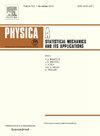Complex network-based framework for flow pattern identification in vertical upward oil–water two-phase flow
IF 2.8
3区 物理与天体物理
Q2 PHYSICS, MULTIDISCIPLINARY
Physica A: Statistical Mechanics and its Applications
Pub Date : 2025-02-11
DOI:10.1016/j.physa.2025.130351
引用次数: 0
Abstract
The investigation of oil–water two-phase flow in vertical pipelines holds significant research implications for a multitude of industrial applications, including oil production, chemical processing, and wastewater treatment. This research introduces a complex network-based framework for analyzing multi-node measurement signals from an eight-electrode cyclic excitation conductivity sensor, aimed at recognizing intricate flow patterns in vertical upward oil–water two-phase flow. Initially, experiments on vertical upward oil–water two-phase flow were conducted in a 20 mm diameter pipeline, where flow dynamics were recorded using the aforementioned sensor. During the experiments, flow patterns captured by a high-speed camera included dispersed oil-in-water slug flow (D OS/W), dispersed oil-in-water flow (D O/W), and very fine dispersed oil-in-water flow (VFD O/W). Subsequently, the multivariate pseudo-Wigner–Ville distribution time–frequency representation (PWVD TFR) was employed to characterize the flow behavior from both energy and frequency perspectives. Finally, the sensor’s measurement nodes were treated as nodes in a network, and the mutual information between each time series was calculated to construct a complex network; network metrics were then computed to quantitatively characterize the network topology. The findings indicate that our method can effectively integrate multi-channel measurement signals and reveal the evolution of complex flow behaviors.
求助全文
约1分钟内获得全文
求助全文
来源期刊
CiteScore
7.20
自引率
9.10%
发文量
852
审稿时长
6.6 months
期刊介绍:
Physica A: Statistical Mechanics and its Applications
Recognized by the European Physical Society
Physica A publishes research in the field of statistical mechanics and its applications.
Statistical mechanics sets out to explain the behaviour of macroscopic systems by studying the statistical properties of their microscopic constituents.
Applications of the techniques of statistical mechanics are widespread, and include: applications to physical systems such as solids, liquids and gases; applications to chemical and biological systems (colloids, interfaces, complex fluids, polymers and biopolymers, cell physics); and other interdisciplinary applications to for instance biological, economical and sociological systems.

 求助内容:
求助内容: 应助结果提醒方式:
应助结果提醒方式:


